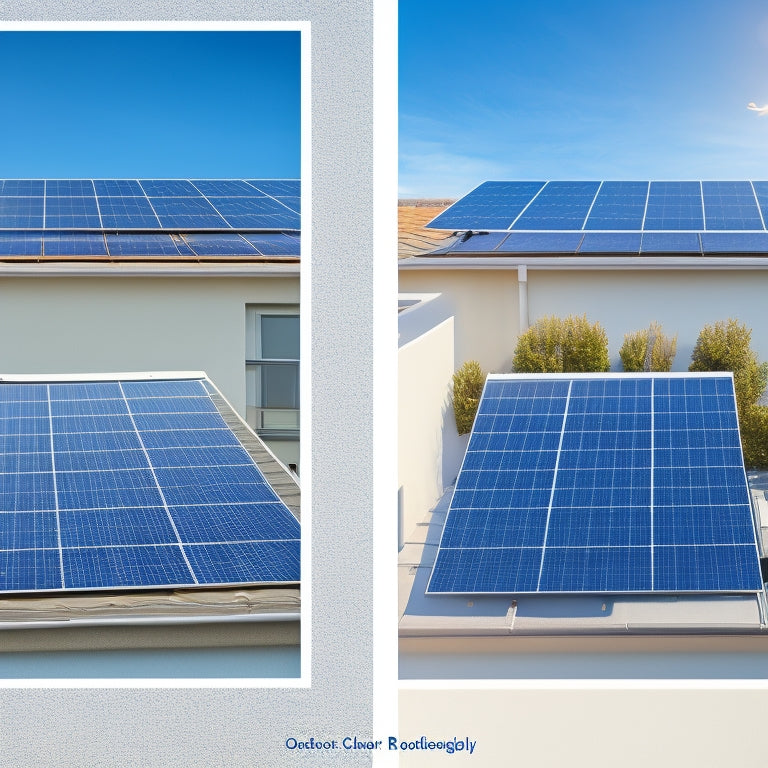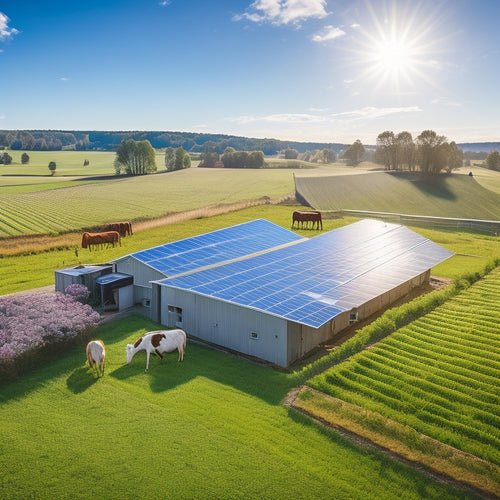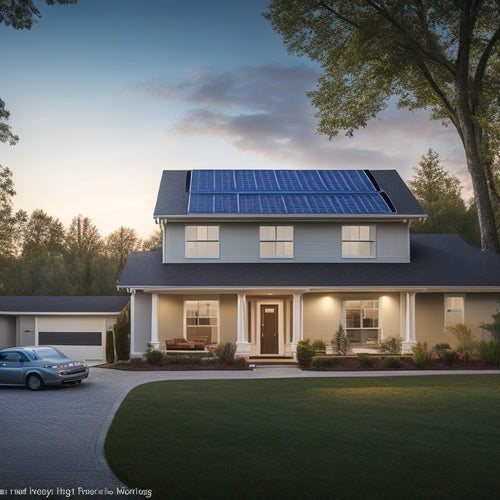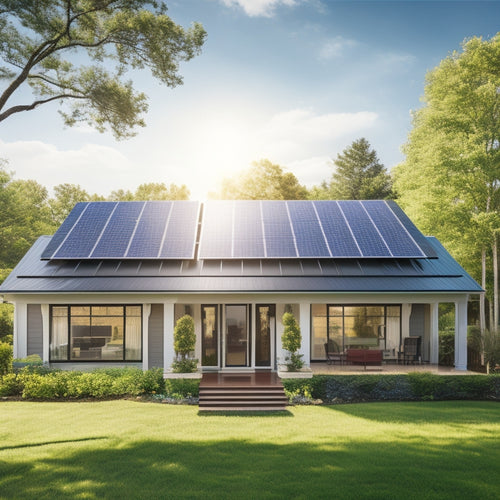
Optimal Solar Panel Angle for Homes
Share
When it comes to utilizing solar energy, you'll want to optimize your solar panel's angle to maximize its output. The ideal angle varies depending on your location, latitude, and local climate. In general, regions near the equator require shallower angles, while polar regions need steeper angles. You'll also need to evaluate seasonal adjustments, as winter requires a steeper angle for low sun capture, and summer requires a shallower angle to prevent overheating. By fine-tuning your solar panel's angle, you can increase energy output by up to 45%. Now, explore deeper into the specifics of your region and roof type to reveal your solar panel's full potential.
Key Takeaways
- The optimal solar panel angle for homes depends on the local latitude, with shallower angles near the equator and steeper angles near the poles.
- Climate factors like humidity and weather patterns also impact the ideal angle, with adjustments needed for regions with high humidity or heavy snowfall.
- Seasonal variations require angle adjustments, with steeper angles in winter (60-70°) and shallower angles in summer to prevent overheating.
- Roof type and material influence the installation angle, with asphalt shingle roofs requiring shallower angles and metal roofs allowing for steeper angles.
- Conducting a site assessment is crucial to determine the ideal panel placement, considering local weather patterns, shading factors, and roof type.
Understanding Solar Panel Efficiency
When you invest in a solar panel system, you expect it to generate maximum power from the available sunlight. To achieve this, it's crucial to understand solar panel efficiency, which is the rate at which solar panel technology converts sunlight into usable energy.
The energy conversion process involves photovoltaic cells absorbing photons from sunlight and generating an electrical current. The efficiency of this process depends on various factors, including the quality of the solar panels, temperature, and shading.
High-efficiency inverters with an efficiency rating above 95% optimal energy production can also greatly impact overall energy production. Additionally, selecting the right type of solar panel, such as monocrystalline or polycrystalline, can influence overall system performance.
A higher efficiency rating indicates that the solar panel system can convert more sunlight into electricity, resulting in increased energy production. By understanding the factors that influence solar panel efficiency, you can maximize your energy output and get the most out of your investment.
Calculating Ideal Angle for Location
When calculating the ideal solar panel angle for your location, you'll need to take into account three key factors.
First, your latitude and longitude will influence the best angle, as they affect the sun's path across the sky. Additionally, you'll need to account for your elevation, local obstructions, and climate, as these variables can impact the amount of sunlight your panels receive.
For instance, south-facing solar panels can capture direct sunlight during peak hours, enhancing energy generation.
Moreover, seasonal variations due to Earth's axial tilt should also be taken into account to improve energy production.
Latitude and Longitude Matter
Your location's latitude and longitude greatly impact the ideal angle for your solar panels. As you move towards the poles, the sun's rays hit the Earth at an angle, requiring adjustments to your panel orientation for peak energy production.
Geographic factors like latitude and longitude influence the number of sunlight hours your location receives, affecting the amount of solar exposure your panels get. To maximize energy production, installation techniques must consider these factors and make angle adjustments accordingly.
Elevation and Obstructions Count
You'll need to contemplate your property's elevation and any obstructions when determining the ideal angle for your solar panels. The elevation impact on your solar panel angle is essential, as a higher elevation means less atmospheric interference, allowing your panels to utilize more energy.
Conversely, lower elevations may require a steeper angle to compensate for increased atmospheric interference.
Conduct an obstruction analysis to identify any objects that may cast shadows on your solar panels. This includes trees, buildings, and even roof features like vents or skylights.
Local Climate Considerations
The latitude of your location greatly influences the ideal solar panel angle, as it affects the sun's path across the sky. In regions near the equator, the sun's path is more vertical, requiring a shallower angle. Conversely, locations closer to the poles require a steeper angle to compensate for the sun's lower course.
Additionally, local climate considerations, such as humidity effects and weather patterns, play a significant role in determining the best angle. For instance, areas with high humidity may benefit from a slightly steeper angle to minimize moisture accumulation on the panels.
Similarly, regions prone to heavy snowfall may require a steeper angle to guarantee snow slides off easily. By considering these factors, you can calculate the ideal angle for your location and maximize your solar panel's energy output.
Seasonal Adjustments for Maximum Output
As you optimize your solar panel's angle for maximum energy production, you'll need to take into account seasonal adjustments to account for the changing sun's position.
During winter, you'll want to adjust your panels to a steeper angle, typically between 60°-70°, to capture more of the low-angled sunlight Flexible Tilt Mounting Systems. This adjustment can enhance energy output, and when combined with advanced modeling for structural integrity, guarantees a secure installation.
While in summer, a shallower angle will help prevent overheating.
Winter Angle Adjustments
How much energy can you squeeze out of your solar panels during the shortest days of the year?
Winter's shorter days and lower sun angles reduce energy output, but adjusting your panel angle can help.
During winter, the sun is lower in the sky, so you'll want to tilt your panels at a steeper angle to maximize energy production. Aim for an angle 10-15 degrees steeper than your latitude to compensate for the lower sun.
This adjustment will help reduce energy loss due to snow accumulation, which can block sunlight and further decrease output.
Summer Tilt Optimization
Your solar panels' summer performance is essential to maximizing energy output throughout the year.
During the summer months, the sun is high in the sky, and its path changes, affecting the angle of incidence on your solar panels. To optimize energy production, you should adjust your panels' tilt to match the sun's path.
-
By doing so, you'll increase energy output by up to 10% compared to a fixed tilt system.
-
You'll also reduce the angle of incidence, minimizing reflection and heat gain.
With solar tracking, you can further optimize energy production by flexibly adjusting the tilt and azimuth to follow the sun's path, resulting in up to 45% more energy output.
Roof Type Considerations for Angle
When determining the ideal solar panel angle for your home, the type of roof you have plays a significant role in your calculations.
Different roof materials impact the installation angle effects, which in turn affect the solar panel's energy output. For instance, asphalt shingle roofs require a more shallow angle to guarantee the panels don't lift or damage the shingles, while metal roofs can accommodate steeper angles.
Slate or clay tile roofs may require specialized mounting systems, which influence the installation angle.
It's crucial to take into account your roof type when calculating the best solar panel angle to guarantee a secure and efficient installation.
Obstruction and Shading Factors
Surrounding obstructions and shading factors greatly impact the ideal solar panel angle for your home. These factors can markedly reduce the energy output of your solar panels.
To determine the best angle, you need to conduct a shading analysis to identify potential obstructions such as trees, buildings, or chimneys.
-
Imagine waking up to a reduced energy output because of a nearby tree's growing branches.
-
Visualize the frustration of dealing with a neighbor's new construction project blocking your solar panels.
-
Envision the disappointment of investing in solar panels only to find out they're not producing as expected due to shading issues.
Understanding obstruction impacts on your solar panels is vital to maximizing energy production.
Regional Variations in Optimal Angle
As you've carefully considered obstruction and shading factors, it's important to investigate how your location influences the ideal solar panel angle.
The sun's path varies depending on your latitude, so it's important to adjust the angle accordingly. In regions closer to the equator, the sun is higher in the sky, requiring a more shallow angle. Conversely, locations closer to the poles require steeper angles to maximize energy production.
Make angle adjustments based on your region's solar irradiance patterns to optimize energy output. For instance, in the northern hemisphere, a tilt of 30-40 degrees is suitable for most locations, while areas near the equator may require a tilt of 10-20 degrees.
Frequently Asked Questions
Can I Adjust My Solar Panel Angle Myself or Do I Need a Professional?
You're like a skilled chef, fine-tuning a recipe - tweaking your solar panel angle for maximum output. While DIY adjustments are possible, it's recommended to opt for professional installation to guarantee precise calibration, avoiding costly mistakes and maximizing energy harvest.
How Often Should I Clean My Solar Panels to Maintain Optimal Performance?
You should clean your solar panels every 6-12 months as part of regular solar panel maintenance to guarantee peak performance, depending on your location's climate and debris accumulation, and consider cleaning more frequently in areas with high dust or pollen levels.
Do Solar Panels Work During Power Outages or Grid Failures?
In a pinch, you're left in the dark - unless you're ahead of the game. During power outages, you can still utilize solar energy storage, achieving grid independence, but only if you've invested in a battery backup system, allowing you to shine on.
Can I Install Solar Panels on a Metal or Asbestos Roof?
When considering installing solar panels on your metal roof, you'll need to assess metal roof considerations, such as ensuring a secure attachment system and avoiding corrosion. If you have an asbestos roof, you'll require asbestos safety precautions, like hiring a certified abatement professional to handle removal.
Are There Any Local Incentives for Installing Solar Panels on My Home?
"Cut to the chase" and investigate local incentives for installing solar panels on your home; you'll likely uncover tax credits and rebate programs that can greatly offset the upfront cost, making your investment more financially fruitful.
Related Posts
-

What Do I Need to Know About Farm Solar Panels
When considering farm solar panels, you need to assess costs, benefits, and technical specifics. Initial investment c...
-

Cost of Solar With Battery Backup
You're investing in a solar panel system with battery backup to guarantee reliable power during outages. The cost of ...
-

Home Solar Installation Cost
You're considering installing solar panels on your home, and the upfront cost is likely the biggest hurdle standing i...


